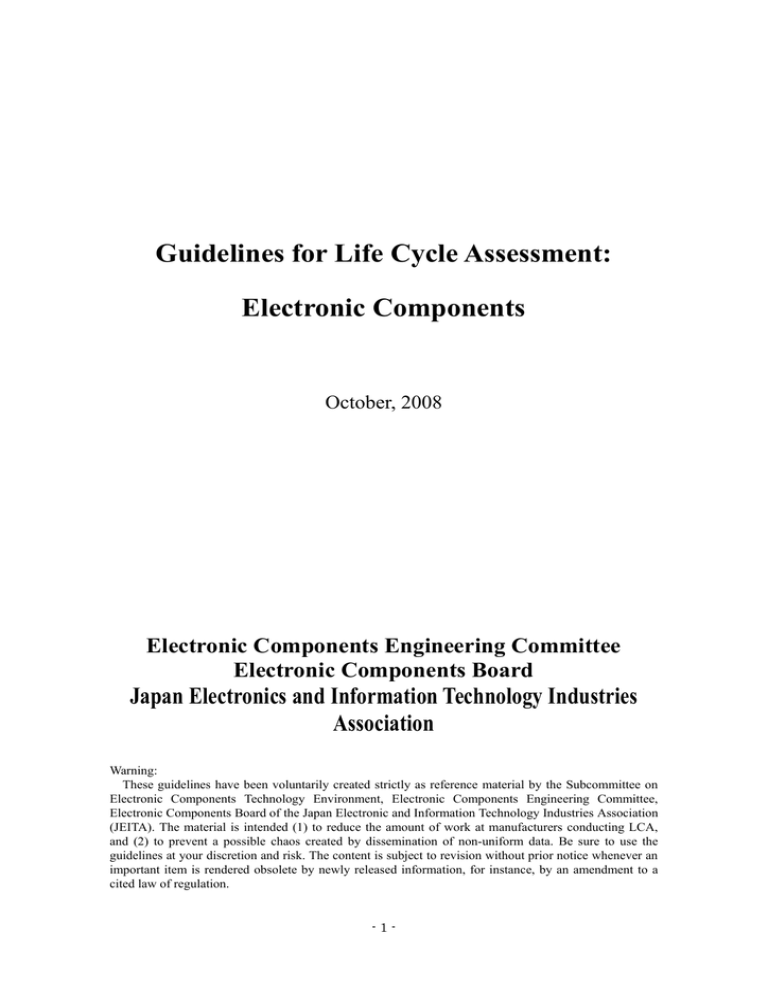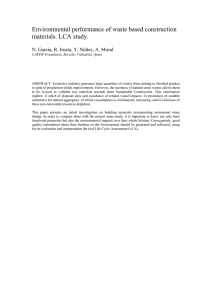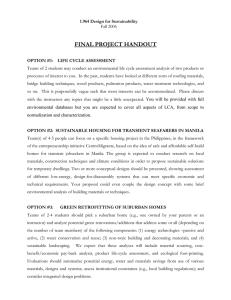Guidelines for Life Cycle Assessment: Electronic Components
advertisement

Guidelines for Life Cycle Assessment: Electronic Components October, 2008 Electronic Components Engineering Committee Electronic Components Board Japan Electronics and Information Technology Industries Association Warning: These guidelines have been voluntarily created strictly as reference material by the Subcommittee on Electronic Components Technology Environment, Electronic Components Engineering Committee, Electronic Components Board of the Japan Electronic and Information Technology Industries Association (JEITA). The material is intended (1) to reduce the amount of work at manufacturers conducting LCA, and (2) to prevent a possible chaos created by dissemination of non-uniform data. Be sure to use the guidelines at your discretion and risk. The content is subject to revision without prior notice whenever an important item is rendered obsolete by newly released information, for instance, by an amendment to a cited law of regulation. -1- Guidelines for Life Cycle Assessment: Electronic Components Introduction In recent years, various techniques have been studied for assessment of environmental impacts of economic activities in terms of the concept of sustainable development. Life cycle assessment (LCA) is one such technique that is drawing attention today. LCA is an assessment technique based on life cycle thinking (LCT). It addresses the total environmental impacts of a product throughout its entire life cycle. In August 2005, the “EuP Directive” (the “2005/32/EC Framework Directive”) took effect in the European Union. LCA is becoming increasingly more important. EU aims at covering the entire life cycle of every electrical product by enforcing three directives and one regulation―the RoHS Directive, WEEE Directive, REACH Regulation, and EuP Directive―and ultimately contributing to evaluation and reduction of their impacts on environment. The term “EuP” here refers to energy-using products. One of the requirements of the EuP Directive is that every energy-using product, such as an electrical product, must have its environmental impacts evaluated throughout the entire life cycles. Research in LCA had already been started in various fields by the time the EuP Directive was announced and put to force. Of various components and materials constituting electrical products, a relatively abundant amount of LCA data are now available on metallic and plastic materials. On the other hand, few data are available on electronic components. The situation and the fact that LCA is still in a developmental stage are a source of concern. A chaos may very well occur as electronic-component manufacturers independently evaluate and circulate LCA data in their attempt to conform to the EuP Directive. Accordingly, we have generated these LCA guidelines for the electronic component industry in contribution to prevention of a data chaos and reduction in LCA workload at individual manufacturers in the industry. 1. Purpose The goal of these guidelines is to standardize the procedure for conducting an LCA on electronic components. 2. Applicability These guidelines are applicable to electronic components. -2- 3. Scope of LCA Of the entire life cycle of an electronic component, LCA is applicable only to that manufacturing process of a product (electronic component) which the electronic component manufacturer is capable of evaluating responsibly. 4. Definition of terms Function ―refers to performance of the product which will be used as a standard in comparing various products with one another using the findings of an LCA made on them. Functional unit ―refers to the quantified function of the product that is used as the standard. The function and functional unit are important in making a comparison―between new and old products, between products of the same kind from the own and other companies, between products of different kinds, and so forth. Raw material —refers to that material, component or part, out of all materials input into a manufacturing process as essential requirements, which actually becomes a constituent, component or part of a product. System boundary ―refers to the boundary between a product system under an LCA and environment or another product system. An LCA is conducted on all processes included within a system boundary. Wastes ―refer, for the purpose of these guidelines, to all materials discharged from a manufacturing process, including a material that has been disposed of as a valuable resource but excluding all general wastes. Ancillary material ―refers to that material out of all materials input into a manufacturing process as -3- an essential requirement which does not become a constitute part of a product. EuP Directive ―refers to EU law: Directive 2005/32/EC of the European Parliament and of the Council of 6 July 2005, establishing a framework for the setting of eco-design requirements for energy-using products (“Directive on Eco-Design of Energy-using Products”). LCA —or Life Cycle Assessment, refers to a method of evaluating the potential environmental impacts of a product throughout all stages―from the mining of natural resources, manufacture and procurement of components and materials, manufacture, use, to disposal or recycling―and consists of the following four phases: (1) the goal- and scope-setting phase for an LCA, (2) the life cycle inventory analysis phase, (3) the life cycle impact assessment phase, and (4) the life cycle interpretation phase. LCI ―or Life Cycle Inventory, refers to a quantitative compilation of inputs into and outputs from the part of an entire life cycle that is within the scope of an LCA study, and becomes the basic data to be used in conducting the LCA. LCT ―or Life Cycle Thinking, refers to giving consideration to the eitire life cycle of a product. REACH Regulation ―refers to EU law: Regulation (EC) No. 1907/2006 of the European Parliament and of the Council concerning the Registration, Evaluation, Authorisation and Restriction of Chemicals. RoHS Directive ―refers to EU law: Directive 2002/95/EC of the European Parliament and of the Council on the restriction of the use of certain hazardous substances in electrical -4- and electronic equipment. WEEE Directive ―refers to EU law: Directive 2002/96/EC of the European Parliament and of the Council on waste from electrical and electronic equipment. 5. Procedure for conducting an LCA The principles and framework of LCA and the requirements and guidelines of LCA are defined in ISO 14040 and ISO 14044, respectively. Explanation on the procedure and associated items for conducting an LCA is given below in the order of the item numbers appearing in ISO 14040. No. 5.2 Setting the goal and scope definition No. 5.2.1.1 The goal of an LCA The goal of an LCA is to study the environmental impacts of an electrical component throughout its life cycle. No. 5.2.1.2 The scope of an LCA An LCA is to cover those manufacturing processes of a product (electronic component) in its life cycle which the manufacturer is capable of evaluating responsibly. No. 5.2.2 The function and functional unit It is difficult to define and explain the functions and functional units that would be universally applicable to all electronic components. Accordingly, only the definitions of these terms are included in these guidelines. If LCA studies are to be used to compare new and old products, own product against another manufacturers product of the same type, products of different types, and so forth, the LCA performer should select and/or define the functions and functional units to suit the goal and scope of the LCA. No. 5.2.3 System boundary The system boundary for the purpose of LCA studies under these guidelines is the manufacturing processes of electronic components. -5- No. 5.2.4 Data quality requirements The significance of data quality requirements is described in this item (No. 5.2.4 of ISO 14040). The actual data quality requirements are given in item 4.2.3.6 of ISO 14044. The following are recommended as the data quality requirements for an LCA to be performed under these guidelines: Time-related coverage – Data should be collected from as recent year as possible or over a specific period of time. Geographical coverage – Electronic components are often manufactured in a multiple of countries or sites. For this reason, these guidelines set no restrictions, requirements or recommendations relating to the geographical coverage of an LCA. Technology coverage – Data on mass-production processes of an electronic component should be used. No. 5.3 Life cycle inventory analysis Life cycle inventory (LCI) analysis is the constructional phase of an LCA in which the inputs and outputs throughout a life cycle within the scope of the LCA are compiled and quantified. A specific procedure, recommended for an LCI under these guidelines, is described in the next item, No. 5.3.2, Data collection. No. 5.3.2 Data collection (I) Types of data to be collected Data on the inputs into and outputs out of the manufacturing processes of an electronic component within the scope of data collection (that is, the system boundary) must be collected. The collected data must be processed to ultimately arrive at a figure for one unit of the product. Table 1 below lists the recommended types of data to be collected. The types as listed are examples of basic types of data to be collected. Additional types of data may be required and some types may have to be eliminated to suit the goal and applications of the LCA. -6- Table 1 Recommended data collection Input Output Types Unit Energy*1 Electric power Kerosene Fuel oil LPG LNG City gas kWh L L kg kg Nm3 Resources Raw materials Ancillary materials Water *1 Basically, only kg kg m3 the energy Types Unit Emissions into atmosphere *2 kg kg kg kg CO2 NOx SOx Dust and soot Wastewater*3 Waste water m3 Wastes*4 Wastes consumed in kg the electronic-component manufacturing processes and associated facilities is to be studied. No energy consumed in transport is studied. *2 The emissions into the atmosphere originating from the burning of fuel are calculated from fuel consumption. Consequently, no separate data collection is required. Emission factors are given in Table 2. *3 The wastewater here refers only to the factory-type wastewater. Domestic-type wastewater is excluded. Domestic-type wastewater may be included if it is difficult to extract separate data on it. *4 The wastes here are industrial wastes including those that have been disposed of as valuable resources. No general wastes are to be included. General wastes may be included if it is difficult to extract separate data on them. Table 2 Emission Factors for NOx, SOx, and SPM (Suspended Particulate Matter) NOx SOx SPM emission emission emission factor factor factor Fuel oil A* 1 kL 6.85 5.99 0.31 Fuel oils B* and C* 1 kL 3.14 18.96 1.52 Kerosene 1 kL 2.00 0.19 0.21 -7- Diesel fuel 1 kL 19.77 2.04 1.66 Gasoline 1 kL 17.15 0.59 0.64 LPG 1t 3.57 0.10 0.25 LNG, natural gas 1t 3.25 0.01 0.43 1.74 0.03 0.37 City gas 3 1000 Nm Source: NOx, SOx and SPM: Keisuke Nansai, Yuichi Moriguchi, Susumu Tohno (Center for Global Environmental Research, National Institute for Environmental Studies). Embodied Energy and Emission Intensity Data for Japan Using Input-Output Tables (3EID); Embodied Intensity Data File, 1995―Electronic component sector, 2002. (II) Data collecting method It is recommended that plant data be collected on the LCA items in accordance with the approach as given in ISO 14040, item Nos. 5.3.2 for data collection and No. 5.3.4 for allocation; and the allocation procedure as given in ISO 14044, item No. 4.3.4; and be allocated (that is, allocation, aggregation, and calculation of proportions by the product group) such that a figure for one unit product is obtained. Allocation is to be made using an element interrelated with the environmental impact of the product, such as the volume, weight, or price, so as to arrive at a figure for one unit product. The procedure and examples of allocation are shown in the Appendix to Guidelines for Electronic Component LCA―LCI Data Calculation Manual. No. 5.4 Life cycle impact assessment Life cycle impact assessment (LCIA) is a phase for selecting what specific environmental impact categories to be used as the basis for assessing a product. The inventory data are to be associated with categories so elected. The procedure is standardized in ISO 14044. In recent years, environmental impact assessment is extensively made on the basis of global warming. These guidelines will also illustrate a sample impact assessment technique using global warming as the basis. If global warming is used as the impact category, the environmental impact to be -8- obtained is the sum total of the CO2 emissions calculated for every type of energy consumed. The following is the equation for the environmental impacts based on the collected data: Environmental impacts: CO2 emissions = ∑ (Amount of energy consumed by the type × CO2 conversion factor) Tables 3 and 4 show the standards for converting energy consumption into CO2. Table 3 CO2 conversion factor for electric power Note: The conversion factor for the year the data was collected must be used. This table shows examples of the CO2 conversion factors for the past three years as published by the Federation of Electric Power Companies of Japan. Year CO2 emission factor kg – CO2 / kWh 2005 0.42 2006 0.41 2007 0.45 Source: Receiving-end factor by the Federation of Electric Power Companies of Japan Table 4 CO2 emission factor for fuel CO2 emission factor Kerosene 1 kL 2.49 Diesel fuel 1 kL 2.62 Fuel oil A 1 kL 2.71 Fuel oils B and C 1 kL 2.98 Liquefied petroleum gas (LPG) Petroleum-derived hydrocarbon gas t 1000 Nm Liquefied natural gas (LNG) t -9- 3.00 3 2.34 2.70 Natural gas Coke oven gas 1000 Nm3 2.08 3 0.85 1000 Nm Blast furnace gas 1000 Nm3 0.33 Linz-Donawitz converter gas 1000 Nm3 1.18 3 2.08 City gas 1000 Nm Source: Ministry of Environment / Ministry of Economy, Trade and Industry. Manual of Calculation and Reporting of Greenhouse Gas Emissions ver. 2.3, May 30, 2008 No. 5.5 Life cycle interpretation Life cycle interpretation is described as the final phase of the LCA procedure, in which the results of an LCI or an LCIA, or both, are summarized and discussed as a basis for conclusions, recommendations and decision-making in accordance with the goal and scope definition. The procedure is standardized in ISO 14044. It is assumed that the party conducting an LCA would also conduct life cycle interpretation in an appropriate manner. Accordingly, no life cycle interpretation procedure is presented herein. No. 7. Critical review Critical review is a process to ensure that the methods used to carry out the LCA are consistent with ISO 14040 and scientifically and technically valid, and that the data used are appropriate and reasonable in relation to the goal of the study. Critical review is optional in an LCA. An LCA, however, requires a critical review if it is to be publicly disclosed and used to support comparative assertions. As critical review is an optional phase depending on the goal of the LCA, these guidelines only give the definition, while omitting the procedure for it. 6. Attached documents Appendix to the Guidelines for LCA: Electronic Components―LCI Data Calculation Manual 7. Reference documents ISO 14040: 2006 (E), Environmental management―Life cycle assessment― Principles and framework, Second edition, July 1, 2006 - 10 - ISO 14044: 2006 (E), Environmental management―Life cycle assessment― Requirements and guidelines, First edition, July 1, 2006 Life Cycle Assessment―Gensoku oyobi Wakugumi [Principles and Framework]. Japan Environmental Management Association for Industry, August 20, 1999 - 11 -



